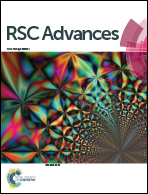A carbon membrane-mediated CdSe and TiO2 nanofiber film for enhanced photoelectrochemical degradation of methylene blue†
Abstract
In this study, a carbon membrane-mediated CdSe and TiO2 ternary film (CdSe/C/TiO2) was prepared to degrade methylene blue (MB). Carbon membrane and CdSe were introduced to the surface of a TiO2 nanofiber film via an in situ hydrothermal deposition process successively. The investigation shows that the carbon membrane not only provides a charge transfer channel to promote the transfer of electron from the conduction band of CdSe to that of TiO2, but also improves the poor conduct between the TiO2 film and electrolyte. The synergies between the carbon membrane and CdSe can make the ternary system harvest more visible light energy and facilitate the charge transfer property of TiO2. The current density of CdSe/C/TiO2 was about 9 folds higher compared with that of pure TiO2 under UV and visible light irradiations. This ternary hybrid exhibits a superior activity during the photoelectrochemical (PEC) degradation of MB, and 92.43% can be removed after 120 min irradiation, which is improved by 21.14% than that of TiO2.



 Please wait while we load your content...
Please wait while we load your content...